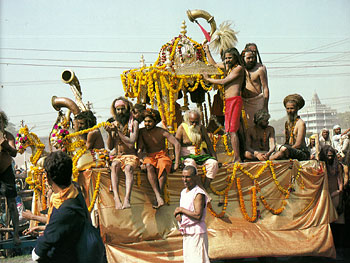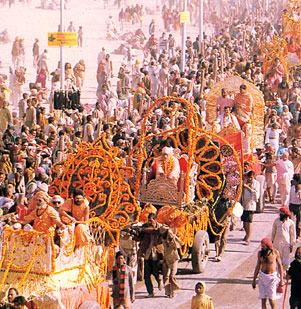
The kumbha mela commenced on Makhara Sankranti with all the pomp, glory, and enthusiasm for which it is justly famous. Temperatures plunged to 35 degrees F on the evening of January 13, but bathers were not discouraged. just past midnight thousands entered the confluence of the three sacred rivers, immersing themselves in the ice-cold water. Loud chanting of "Bolo Ganga mai kijai!" ("All glory to mother Ganga!") filled the clear night air as the pilgrims washed away their bad karma. Bathers emerged from the bathing area wrapped in blankets and shivering from the cold. But as quickly as one group of pilgrims came out of the water, thousands more followed in their wake. With continual chants of 'Bolo Ganga mai kijai.l" the pilgrims entered the sacred waters.
At dawn, the sky reddened, and the sun rose to reveal a crowd of five million enthusiasts slowly advancing toward the sangam. From the center of that mass of humanity emerged a marvelous procession announcing the official beginning of the kumbha mela. Bands played, people danced in jubilation, and colorful flags and banners flew above the crowd.

Leading the kumbha mela procession were the Nagas, India's famed naked holy men. These holy men renounce the world in their search for equilibrium. They hope to escape the world's concomitant reactions and suffering by their austere practices such as celibacy and renunciation of material possessions; thus, they are known as liberationists. With matted locks of hair, their bodies covered in ashes, and their tridents—the symbol of a follower of Shiva—raised high, they descended upon the bathing area. Entering the water in a tumult, blowing conchshells and singing, "Shiva kijai, Ganga kijai," they splashed the sacred waters on one another and frolicked like children. The Nagas are often called the children of the Ganges.
Next in the procession came the Vairagis, the wandering mendicants who dedicate everything to Vishnu, the Sustainer. These saints live a life of service and complete dedication. Each member of their community sees himself as a serving unit, part of the Supreme Being. Vairagis are said to be on the plane of transcendence that is above both the exploitative mentality of the materialists, as well as the concepts of liberation or merging with the nondifferentiated aspect of the Absolute.
Then came the innumerable other sects of ascetics dressed in saffron-colored cloth and carrying their staffs signifying renunciation. Centuries of India's spiritual evolution were simultaneously represented in procession; the Nagas, Vairagis, Shaivites, Shankarites, Ramanujas, Madhvas, Nimbarkas, Gaudiyas. Each sect, in its turn, bathed in the sangam.
Several hours elapsed before the procession of holy men had finished. Then began the mass bathing of the pilgrims. From the high banks of the river one could see the dark blue water of the Yamuna mixing with the silver-gray water of the Ganges. Standing waist-deep, bathers scooped up water with folded palms and offered it to heaven in a timeless gesture. Boatmen rowed their boats full of pilgrims to a small sandbar in the middle of the sangam that soon disappeared under an eclipse of bathers.
